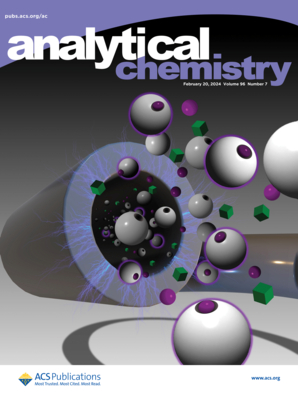A Clamp-Shaped Quartz Tuning Fork-Based Laser Spectroscopy Sensor.
IF 6.7
1区 化学
Q1 CHEMISTRY, ANALYTICAL
引用次数: 0
Abstract
A novel clamp-shaped quartz tuning fork (QTF)-based laser spectroscopy sensor is reported in this paper. The clamp-type structure was created to enhance stress and temperature gradient while optimizing the distribution of surface charges in QTF-based laser spectroscopy. Additionally, this structure eliminates the sharp right angles of the QTF, thereby minimizing performance degradation caused by residual unexpected materials. The QTF features a low resonant frequency (f0, ∼7.59 kHz) and a broad tine spacing. These characteristics contribute to an extended energy accumulation period and a simplified optical alignment process. Quartz-enhanced photoacoustic spectroscopy (QEPAS) and light-induced thermoelastic spectroscopy (LITES) were used to validate its functionality. In QEPAS and LITES simulations, the integrated surface charge of the clamp-shaped QTF was enhanced by 2.48 and 2.96 times, respectively, compared to the widely used standard QTF with an f0 of 32.768 kHz. Experimental data indicate that the signal-to-noise ratio (SNR) of the QEPAS sensor based on the clamp-shaped QTF was improved by 1.92 times compared to the standard QTF. The signal intensity was enhanced 41.3-fold in the clamp-shaped QTF upon integration of an acoustic microresonator (AmR). When the system average time reached 1000 s, a reduction of the acetylene (C2H2) minimum detection limit (MDL) to 28.27 ppb was observed. In the LITES technique, the SNR of the clamp-shaped QTF-based sensor was improved by 2.45 times compared with the standard QTF, with an MDL of 251.4 ppb at a system average time of 100 s. Both theoretical simulations and experimental results in this paper clearly demonstrate the advantages of this clamp-shaped QTF in laser spectroscopy sensing.一种钳形石英调谐叉激光光谱传感器。
本文报道了一种新型的钳形石英音叉(QTF)激光光谱传感器。在基于qtf的激光光谱中,为了提高应力梯度和温度梯度,同时优化表面电荷的分布,建立了钳型结构。此外,这种结构消除了QTF的尖锐直角,从而最大限度地减少了由残余意外材料引起的性能下降。QTF具有低谐振频率(f0, ~ 7.59 kHz)和宽时间间隔的特点。这些特性有助于延长能量积累周期和简化光学对准过程。利用石英增强光声光谱(QEPAS)和光致热弹性光谱(LITES)验证了其功能。在QEPAS和LITES模拟中,钳形QTF的综合表面电荷比目前广泛使用的标准QTF分别提高了2.48倍和2.96倍,前者的f0为32.768 kHz。实验数据表明,基于钳形QTF的QEPAS传感器的信噪比比标准QTF提高了1.92倍。在集成声学微谐振器(AmR)后,钳形QTF中的信号强度增强了41.3倍。当系统平均时间达到1000 s时,乙炔(C2H2)的最小检出限(MDL)降至28.27 ppb。在LITES技术中,与标准QTF相比,钳形QTF传感器的信噪比提高了2.45倍,在系统平均时间为100秒时,MDL为251.4 ppb。理论模拟和实验结果都清楚地证明了这种钳形QTF在激光光谱传感中的优势。
本文章由计算机程序翻译,如有差异,请以英文原文为准。
求助全文
约1分钟内获得全文
求助全文
来源期刊

Analytical Chemistry
化学-分析化学
CiteScore
12.10
自引率
12.20%
发文量
1949
审稿时长
1.4 months
期刊介绍:
Analytical Chemistry, a peer-reviewed research journal, focuses on disseminating new and original knowledge across all branches of analytical chemistry. Fundamental articles may explore general principles of chemical measurement science and need not directly address existing or potential analytical methodology. They can be entirely theoretical or report experimental results. Contributions may cover various phases of analytical operations, including sampling, bioanalysis, electrochemistry, mass spectrometry, microscale and nanoscale systems, environmental analysis, separations, spectroscopy, chemical reactions and selectivity, instrumentation, imaging, surface analysis, and data processing. Papers discussing known analytical methods should present a significant, original application of the method, a notable improvement, or results on an important analyte.
 求助内容:
求助内容: 应助结果提醒方式:
应助结果提醒方式:


